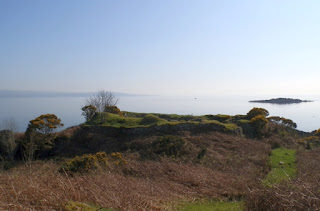After the gig we brought Mike back with us to Carradale for a week’s visit, his first time here and it was intriguing to see his reaction to the place, a far cry from his home town of Yeovil in deepest Somerset. I was watching his face for reaction as we turned along the single-track and he realised that he had yet to endure many miles of the twisting and turning road. Traffic was light, almost non-existent, but nevertheless you are always straining to catch a glimpse of what might be a car coming around the next bend before it is too late to brake, hoping that you will spot the deer at the side of the road before it jumps out in front of the car, dodging the sheep too. Mike only knew this place from what he had read in this blog and it was difficult to guess how it would match up to his own mental picture. As it turned out the lurching along our bendy roads almost got the better of his stomach, spoiling much of his appreciation of the landscape around him.
The views were not at their best anyway as a white haze hung low over Kilbrannan Sound, masking the detail of the indented coastline beside us and completely hiding the coast of Arran. Naturally, we would like Mike to see and experience where we live as it more normally is - the air clear and sharp, freshly scrubbed after rain, a cooling breeze rippling the sea, cloud cover high above - but looking at the forecast for the week ahead we might only be able to offer him clear skies, sunshine and warmth. Convincing him that this weather is a far cry from normality is difficult but he seems happy with this weather nevertheless.
We do the tourist thing and take him out and about, showing off some of the local sights. We begin with what is left of Saddell Abbey, most of the stone from which was taken for use in other later construction projects like the castle by the beach or possibly for local houses. My research tells me that construction here started in 1148 (although how can anyone be so certain about this date is a mystery to me) and our eyes tells us that ever since then, even after the monastery had crumbled away, local people still regard the land as sacred, the gravestones clustered amongst the shadows of the former monastery walls bearing testament to this.
Later we move back in time to view Kildonan Dun, trying desperately to imagine what it might have been like to live in around the year 100 AD when this was most likely built.
The view across the sound from here is impressive today and almost certainly this will have changed little in the last 2000 years. Even the archaeologists can tell us little about this place beyond that it was constructed as a fortified settlement surrounded by farming land. Did the people also fish from boats which they drew up close by in the small bay? Were they able to live peaceably or was life constantly under threat? The stones in the boundary walls are beautifully set together, shaped and positioned back then exactly as they remain today. But by whom? Where did these people come from and where did they go?
Going further back again in time, our next trip takes us to the vitrified fort at Carradale Point. There are a number of these constructions in Scotland all dating from around 1000 BC, the real mystery being how it was possible to raise the temperature of the fort walls to the 1100 degrees Celsius needed to get the rock to melt and fuse together. Once again, nobody will ever know for sure.
Mike’s week with us ended with Betty’s dog, Ailsa, taking us for a walk up Deer Hill then on around the bay. Or at least, this is how she would see it, I’m sure. This normally golden retriever ended the day covered with black mud from the lower belly downwards after she decided to take a dip in a dark peaty pool, but this failed to dampen her enthusiastic tail-wagging. She just sprayed the stuff all over us.
Then having juggled emails with the solar power installation company for some weeks, finally one sunny morning a van-load of men arrive en masse and they are soon prancing about on our roof. It takes them but a few hours, during which time the sun shines effortlessly down, sunlight that is wasted until the final connection is made.Suddenly we are online. From this moment on we are part of the National Grid, making electricity for the rest of the country (and ourselves), a thought that gives us a warm cuddly feeling as well as putting a little in the bank. And as we suspected the end result is visually striking, making our house stand out from the rest, the panels being a landmark we can now use to direct visitors by, a side-benefit we had previously overlooked.
‘Just look for the house with the solar panels.’






